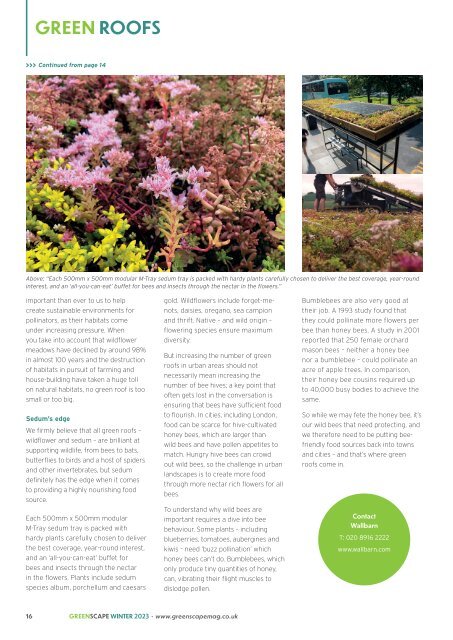Winter 2023
Create successful ePaper yourself
Turn your PDF publications into a flip-book with our unique Google optimized e-Paper software.
GREEN ROOFS<br />
>>> Continued from page 14<br />
Above: “Each 500mm x 500mm modular M-Tray sedum tray is packed with hardy plants carefully chosen to deliver the best coverage, year-round<br />
interest, and an ‘all-you-can-eat’ buffet for bees and insects through the nectar in the flowers.”<br />
important than ever to us to help<br />
create sustainable environments for<br />
pollinators, as their habitats come<br />
under increasing pressure. When<br />
you take into account that wildflower<br />
meadows have declined by around 98%<br />
in almost 100 years and the destruction<br />
of habitats in pursuit of farming and<br />
house-building have taken a huge toll<br />
on natural habitats, no green roof is too<br />
small or too big.<br />
Sedum’s edge<br />
We firmly believe that all green roofs –<br />
wildflower and sedum – are brilliant at<br />
supporting wildlife, from bees to bats,<br />
butterflies to birds and a host of spiders<br />
and other invertebrates, but sedum<br />
definitely has the edge when it comes<br />
to providing a highly nourishing food<br />
source.<br />
Each 500mm x 500mm modular<br />
M-Tray sedum tray is packed with<br />
hardy plants carefully chosen to deliver<br />
the best coverage, year-round interest,<br />
and an ‘all-you-can-eat’ buffet for<br />
bees and insects through the nectar<br />
in the flowers. Plants include sedum<br />
species album, porchellum and caesars<br />
gold. Wildflowers include forget-menots,<br />
daisies, oregano, sea campion<br />
and thrift. Native – and wild origin –<br />
flowering species ensure maximum<br />
diversity.<br />
But increasing the number of green<br />
roofs in urban areas should not<br />
necessarily mean increasing the<br />
number of bee hives; a key point that<br />
often gets lost in the conversation is<br />
ensuring that bees have sufficient food<br />
to flourish. In cities, including London,<br />
food can be scarce for hive-cultivated<br />
honey bees, which are larger than<br />
wild bees and have pollen appetites to<br />
match. Hungry hive bees can crowd<br />
out wild bees, so the challenge in urban<br />
landscapes is to create more food<br />
through more nectar rich flowers for all<br />
bees.<br />
To understand why wild bees are<br />
important requires a dive into bee<br />
behaviour. Some plants – including<br />
blueberries, tomatoes, aubergines and<br />
kiwis – need ‘buzz pollination’ which<br />
honey bees can’t do. Bumblebees, which<br />
only produce tiny quantities of honey,<br />
can, vibrating their flight muscles to<br />
dislodge pollen.<br />
Bumblebees are also very good at<br />
their job. A 1993 study found that<br />
they could pollinate more flowers per<br />
bee than honey bees. A study in 2001<br />
reported that 250 female orchard<br />
mason bees – neither a honey bee<br />
nor a bumblebee – could pollinate an<br />
acre of apple trees. In comparison,<br />
their honey bee cousins required up<br />
to 40,000 busy bodies to achieve the<br />
same.<br />
So while we may fete the honey bee, it’s<br />
our wild bees that need protecting, and<br />
we therefore need to be putting beefriendly<br />
food sources back into towns<br />
and cities – and that’s where green<br />
roofs come in.<br />
Contact<br />
Wallbarn<br />
T: 020 8916 2222<br />
www.wallbarn.com<br />
16 GREENSCAPE WINTER <strong>2023</strong> • www.greenscapemag.co.uk

















